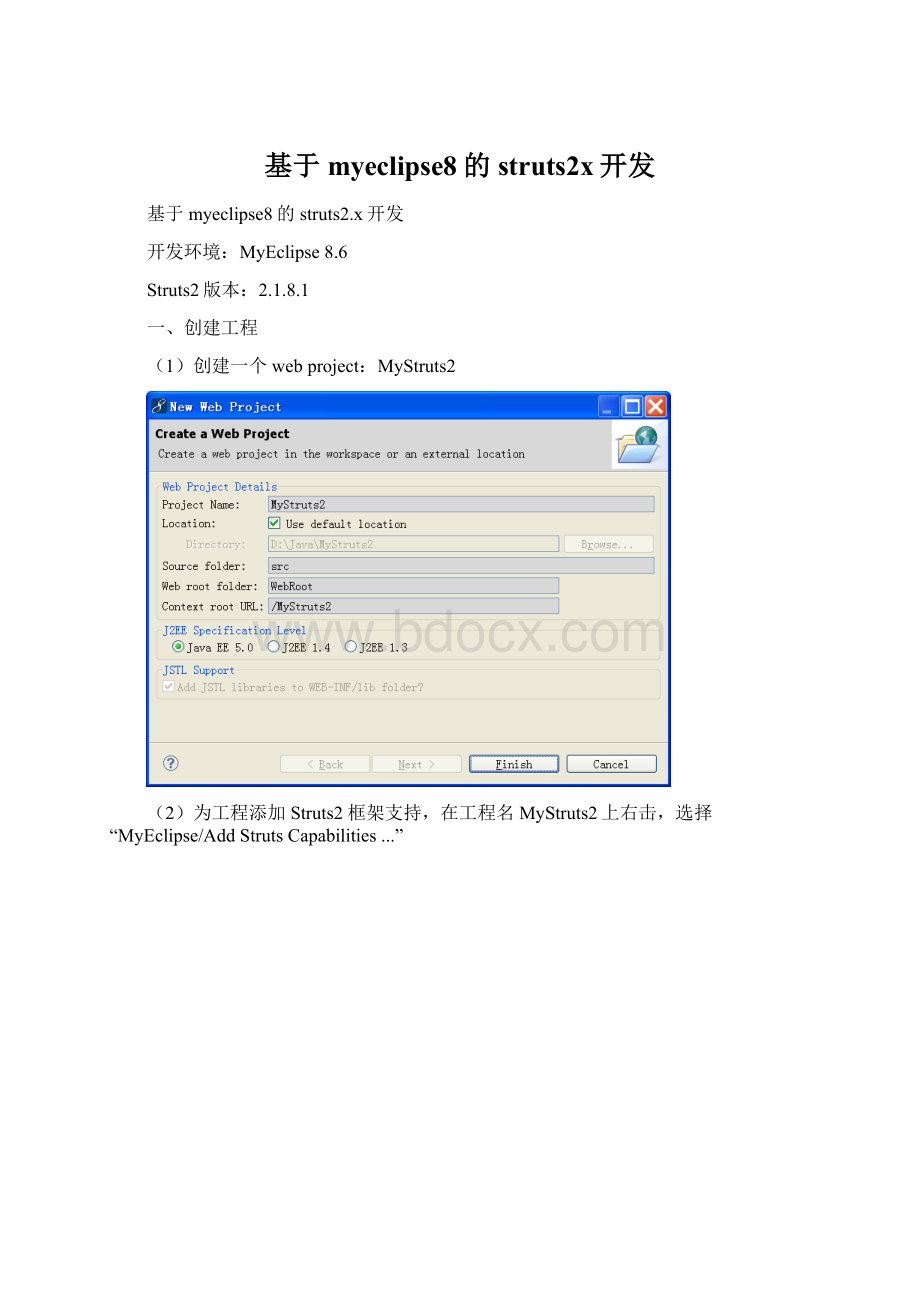基于myeclipse8的struts2x开发.docx
《基于myeclipse8的struts2x开发.docx》由会员分享,可在线阅读,更多相关《基于myeclipse8的struts2x开发.docx(14页珍藏版)》请在冰豆网上搜索。

基于myeclipse8的struts2x开发
基于myeclipse8的struts2.x开发
开发环境:
MyEclipse8.6
Struts2版本:
2.1.8.1
一、创建工程
(1)创建一个webproject:
MyStruts2
(2)为工程添加Struts2框架支持,在工程名MyStruts2上右击,选择“MyEclipse/AddStrutsCapabilities...”
(3)在弹出的对话框中选择,Struts2.1
(4)点击完成后,可以看到项目目录中多了Struts2CoreLibraries文件夹,同时src自动生成了struts.xml文件
工程中生成了一个空的struts.xml文件:
xmlversion="1.0"encoding="UTF-8"?
>
DOCTYPEstrutsPUBLIC"-//ApacheSoftwareFoundation//DTDStrutsConfiguration2.1//EN""http:
//struts.apache.org/dtds/struts-2.1.dtd">
另外,Web-INF下的web.xml中多了以下几行(加入Struts2MVC框架启动配置):
struts2
org.apache.struts2.dispatcher.ng.filter.StrutsPrepareAndExecuteFilter
struts2
*.action
<--注:
应该将*.action改为/*,所有请求都可以被拦截,进而寻找对应的action去执行-->
另外:
如果是2.1.3之前的版本,用org.apache.struts2.dispatcher.FilterDispatcher;之后则用org.apache.struts2.dispatcher.ng.filter.StrutsPrepareAndExecuteFilter。
从Struts2.1.3开始,将废弃ActionContextCleanUp过滤器,而在StrutsPrepareAndExecuteFilter过滤器中包含相应的功能。
此时,运行tomcat服务器,在浏览器中输入:
http:
//localhost:
8080/MyStruts2/,应该能够正确显示页面,表明添加Struts2后,没有引起冲突。
总结:
在MyEclipse8中对一个项目中添加struts2支持方法非常简单,只需要进行简单设置,不用手动创建配置文件。
二、struts2简单用例1
示例内容:
添加一个action,在其中处理数据,并将结果在页面上进行显示。
1、添加需要的JSP页面
添加一个页面,用于跳转到的位置,如result.jsp,将页面放在WEB-INF/pages/目录下,是为了保证安全,不让用户直接输入网址进入。
2、添加Action
在struts.xml源文件中右击鼠标,选择MyEclipes/NewAction...
在新弹出的“NewAction”对话框里新建一个Package,如下图所示:
说明:
struts2的Action必须放在指定的包空间下定义,即要设置Package的name;而Namespace是一个路径,与Action名称一起组成action的路径,例如在JSP表单的action属性中设置该action路径,则要用namespace+/+actionname.action组成。
继续添加Action的Name,Class以及Results。
其中Name为action的名称,类似于struts1中的path,即程序中访问该action使用的映射名称;Class为action的完整类名,包括包名与类名。
如下图所示:
注意:
添加Results时,类型选default默认,不能选redirect,否则action将不对给页面传参数。
当然,如果需要传参,也可以通过在路径后面添加参数的方法把参数带上,如location=/WEB-INF/pages/result.jsp?
name=${username}。
实际上,这一步修改了struts.xml文件,即帮我们添加了如下代码:
extends="struts-default">
/WEB-INF/pages/result.jsp
其中,result类似于Struts1.x中的forward元素。
注意jsp页面的路径,如果在工程根目录下,就写成:
/result.jsp
这一步在工程中添加了com.gzzzz.OutputAction.java文件。
3、添加代码逻辑操作,进入OutputAction类:
publicclassOutputActionextendsActionSupport{
privateStringMsg; //添加一个变量
publicStringgetMsg(){ //添加getter
returnMsg;
}
publicStringexecute(){
Msg="results:
"+(10+20); //逻辑运算
returnSUCCESS;//预定义常量
}
}
2.4在result页面对msg进行显示
${msg} //EL表达式
说明:
EL表达式的变量名,要与Action中的getMsg函数名要对应(即将Msg变为msg),而与相关成员变量名不必保持对应,虽然我们通常这样做。
4、运行程序
在浏览器出输入:
http:
//localhost:
8080/MyStruts2/output.action
这样会出错。
在调用action之前要加上Namespace。
输入改为:
http:
//localhost:
8080/MyStruts2/mypath/output.action
如下,所示,看到了我们想要的结果:
三、struts2简单用例2
示例内容:
用户登陆功能。
1、添加需要的JSP页面
添加login.jsp,代码如下:
<%@pagelanguage="java"pageEncoding="GBK"%>
<%@tagliburi="/struts-tags"prefix="s"%>
DOCTYPEHTMLPUBLIC"-//W3C//DTDHTML4.01Transitional//EN">
LoginPage
--
-->
actionerror/>
formaction="/mystruts2/login.action"method="post">
textfieldname="username"label="username"/> fielderrorkey="msg.error"/> |
passwordname="password"label="password"/> |
submitvalue="提交"/>
|
form>